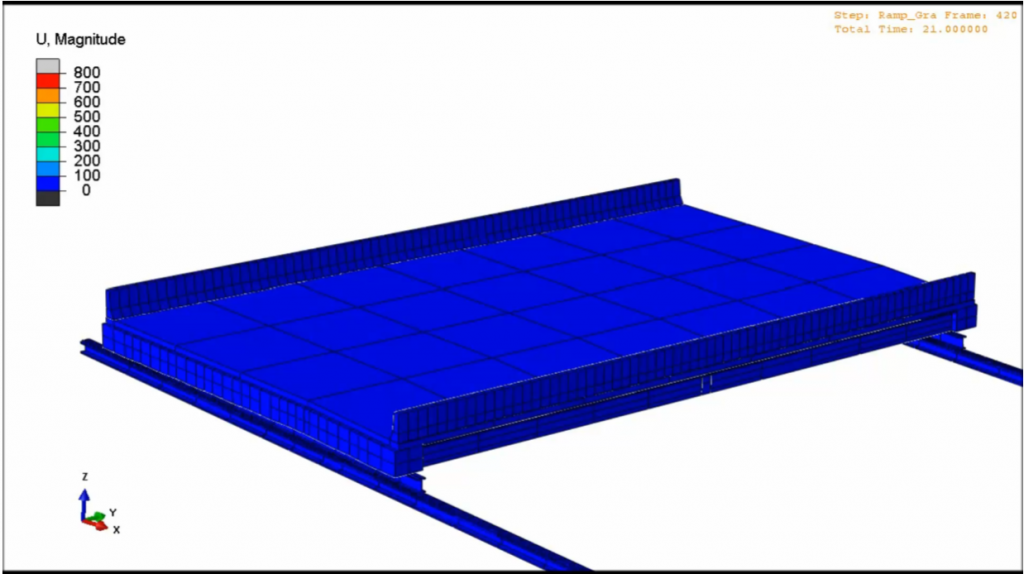Registration is now open for the 3DEXPERIENCE Modeling and Simulation Virtual Conference (ModSim) on November 17-18, 2020. This global conference will inspire users to design and innovate the next generation of products by offering learning opportunities through user presentations on industry applications, product and technology updates. Below is an interview with one of the academic speakers, Dr. Upul Attanayake, giving insight on what he will present at the conference. You can find the full presentation here.
What is the title of your presentation?
Title: Investigation of bridge substructure damage potential during lateral slide activities
To reduce disruption to traffic during bridge replacement, accelerated bridge replacement (ABR) methodologies are being developed. One of the ABR methodologies being implemented is slide-in bridge construction (SIBC), which reduces the total duration of traffic disruption to less than one or two weekends. Because the SIBC activities are new, the system response is unknown. The Abaqus FEA was used to investigate the substructure response under sliding loads. This presentation describes:
- bridge slide activities and structural response analysis
- use of Abaqus to simulate complex infrastructure problems
- application of dynamic explicit analysis to simulate bridge slide operations
- application of linear elastic property definitions and the Mohr-Coulomb constitutive model for soil-structure interaction modeling

Please describe why you chose this topic for your project.
Because the SIBC activities are new, the system response is unknown. There was a need to investigate structural response as well as the forces acting on bridge substructure to standardize design procedures. This topic covers the evaluation of a very complex infrastructure problem using advanced simulation tools.
What are three main takeaways the audience can expect at the conclusion of your presentation?
This presentation describes:
- bridge slide activities and structural response analysis
- use of Abaqus to simulate complex infrastructure problems
- application of dynamic explicit analysis to simulate bridge slide operations
- application of linear elastic property definitions and the Mohr-Coulomb constitutive model for soil-structure interaction modeling
What do you see are the benefits of someone listening to your presentation?
Learning the advanced simulation capabilities in Abaqus and their application to investigate complex infrastructure problems.
What were the advantages of using simulation in your project?
Because the SIBC activities are new, the system response is unknown. There was a need to investigate structural response as well as the forces acting on bridge substructure to standardize design procedures.
Why did you choose SIMULIA over other simulation products?
I am an Abaqus user for more than 20 years and know the advanced capabilities that it offers. Use of complex surface interaction definitions, soil-structure interaction modeling, and dynamic explicit capabilities were required for this project, and Abaqus offers such capabilities.
Do you feel that learning simulation skills in University will provide you with an advantage in your career? Please explain.
Yes, Abaqus is a well-known and widely used simulation tool. Learning finite element basics and the application of Abaqus to simulate complex problems opens doors for finding better opportunities and advancing their career. Also, providing an opportunity for students to use a suite of software seamlessly to do the pre- and post-processing has a great benefit to find jobs in many disciplines.

Dr. Upul Attanayake is an Associate Professor of Civil and Construction Engineering at Western Michigan University, Kalamazoo, Michigan. In 1998, he obtained his B.Sc. (Eng.) degree with honors from the Faculty of Engineering, University of Peradeniya, Sri Lanka. Dr. Attanayake was one of the Millennium Scholarship recipients from the Asian Institute of Technology (AIT) in 1999. He obtained his M.Eng degree specialized in Structural/Earthquake Engineering in 2001. Dr. Attanayake was successful in securing a graduate research assistantship from the Center for Structural Durability at Wayne State University, Detroit, Michigan, to continue graduate studies towards his Ph.D. Dr. Attanayake worked on several Michigan Department of Transportation sponsored research projects on condition assessment and health monitoring of highway bridges. Dr. Attanayake’s doctoral research was to develop rational load response analysis models for orthotropic bridge decks integrating the mechanics of materials and macromechanics concepts. Dr. Attanayake graduated from Wayne State University in 2006 and worked as a postdoctoral researcher at the Center for Structural Durability until December 2006. In January 2007, he joined Western Michigan University as a research associate. In August 2008, he assumed duties as an Assistant Professor (term). In 2010, Dr. Attanayake became a tenure-track Assistant Professor. He became an Associate Professor in 2014.
SIMULIA offers an advanced simulation product portfolio, including Abaqus, Isight, fe-safe, Tosca, Simpoe-Mold, SIMPACK, CST Studio Suite, XFlow, PowerFLOW and more. The SIMULIA Community is the place to find the latest resources for SIMULIA software and to collaborate with other users. The key that unlocks the door of innovative thinking and knowledge building, the SIMULIA Community provides you with the tools you need to expand your knowledge, whenever and wherever.
